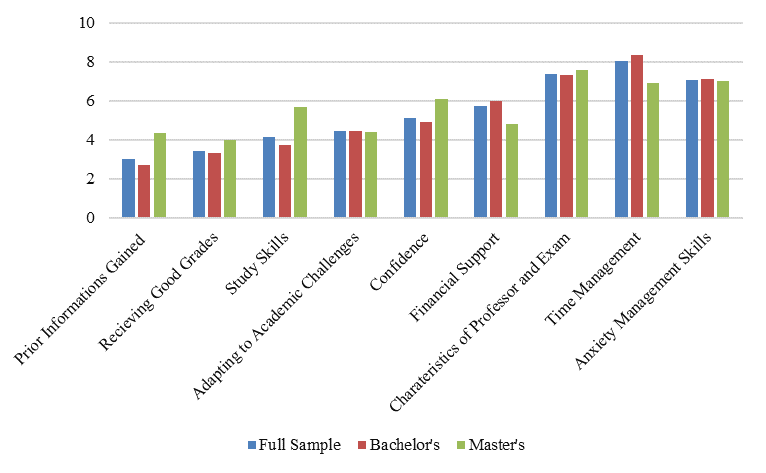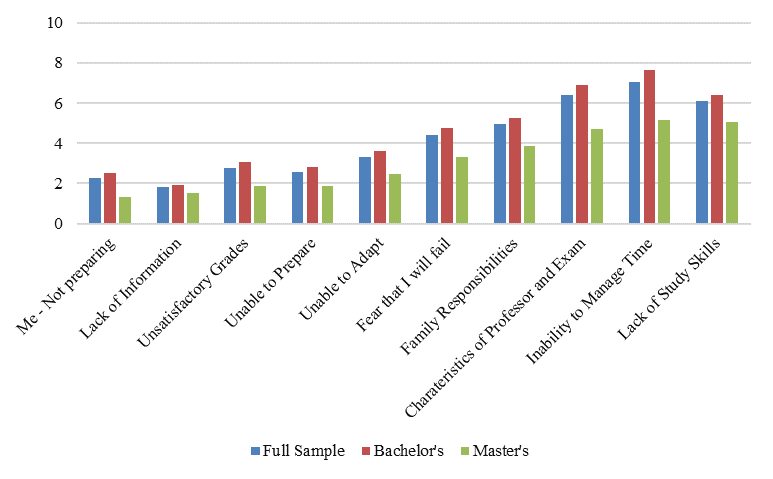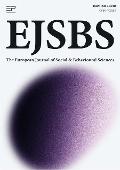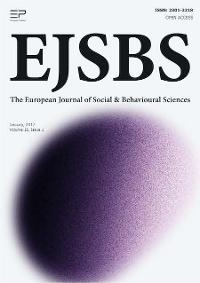Abstract
Worldwide research studies show that anxiety disorders are rising among students. The main goal of this study is to identify the differences in test anxiety among Bachelor and Master level students at the Department of Psychology, University of Prishtina, by identifying the most common factors influencing their test anxiety changes. The first research question aims to examine differences in test anxiety across levels of study, while the second research question aims to identify the most influential factors which impact the reduction or increase of test anxiety level on the above mentioned students. Using the quantitative method, the Test Anxiety Scale Questionnaire (Nist & Diehl, 1990) was used to measure the level at which students experience test anxiety. The measuring instrument consists of an online survey distributed to a sample of (N=59) students. According to the study results, undergraduate students reported significantly higher levels of test anxiety compared to graduate students. Regarding anxiety reduction factors, Masters students reported higher levels of confidence, study skills, receiving good grades, and prior information gained compared to undergraduate students. With regard to anxiety increasing factors, Bachelor level students tended to cite lack of preparation, fear of failing, family responsibilities, characteristics of the professor and exam, lack of time management skills, and lack of study skills as factors related to test anxiety as compared to Masters students.
Keywords: Test anxiety, students, study level, undergraduate, graduate, influential factors
Introduction
One of the most common anxiety types considered to be present among students, as one of the most pervasive reactions that individuals have to stress, is test anxiety (Sarson & Sarson, 1990, cited in Burns, 2011). Test anxiety is defined as a “set of phenomenological, psychological, and behavioral responses that accompany concern about possible negative consequences or failure of an exam or similar evaluation situations” (Zeidner, 1998, as cited in Rezazadeh & Tavakoli, 2009, p. 68).
Test anxiety is commonly analysed as a bi-dimensional construct with affective and cognitive components (Morris, Davis, & Hutchings, 1981; Schwarzer, 1986, cited in Cassady, 2001, p.1). In this regard, the cognitive dimension involves worry and negative thoughts, self-criticism or concern about the negative consequences of failure that occurs during test situations (Zeidner, 1998), while also making students ‘freeze up’ mentally, and fail to recall the information needed (Musch & Broder, 1999). Additionally, the emotional component describes the tension that students have during the test, which is manifested through muscle tension, accelerated heart rate, nervousness, or sweaty palms (Asgahari, Kadir, Elias & Baba 2012, p.4).
While both components are considered to impact students emotionally, physically and cognitively, according to (Bandlos, Yates, & Thorndike-Christ, 1995; Williams, 1991; Humbree, 1981, cited in Rana & Mahmood, 2010), it is the cognitive aspect of test anxiety that has been significantly accounted for in the decline of academic achievement of adolescents and postsecondary students. However, according to other perspectives, students’ academic achievements, aside from having a correlation with their level of engagement, is also linked with their behaviors, cognitive and emotional aspects (Fredricks et al., 2004 cited in Lee & Suttle, 2010).
A number of factors are considered to influence test anxiety. Students’ perception regarding the knowledge they have and their inability to enhance their learning has been evaluated within the group of factors affecting student performance and their level of stress (Carveth, Gesse, & Moss, 1996). This factor is manifested through students’ complaints of lacking sufficient time to prepare for the exams or learn the course materials, or not being satisfied with the achieved academic results in the previous evaluations (Abouserie, 1994, cited in Hyseni-Duraku, 2014).
Test anxiety levels are considered to vary during the years of study at the university. A great number of research studies present data that most psychological disorders are evident in first year students. According to a research study carried out by Cooke, Bewick, Barkham, Bradley and Audin (2006), it has been identified that first year students most commonly reveal psychological changes, that often times correlate with students’ financial concerns, and the academic pressure which they encounter. Moreover, according to Wright (1967), it has been established that students’ signs of stress are also most prevalent in those students experiencing difficulties in adjusting to university life.
Professors’ teaching and evaluating methods are also considered to be factors of influence in the academic performance and the anxiety in students. According to Davis (1999), exams and high volume projects are considered to be inadequate forms of evaluation that may negatively impact students’ motivation and their increased experience of anxiety. The most stressful factors influencing students, identified in educational institutions, are evaluations and competitions between students, students’ academic failures, unhealthy relations between students, and course instructors (Fairbrother & Warn, 2003). According to Ericksen (1978), many students respond more positively to better organized courses, led by enthusiastic instructors, who awake students’ interest in the subject and succeed in influencing the students’ learning process. Moreover, it is perceived that constructive learning methods help students take responsibility in learning and enables them to become independent and develop their own concepts pertaining to the subjects being taught (Hyseni-Duraku, 2014).
Other factors of influence in students’ stress level include the lack of adaptability of the university infrastructure, the academic semester functioning methods, and the limited capacity of academic institutions to support the academic efforts of their students (Awino & Agolla, 2008). Furthermore, the high pressure to achieve commendable results in exams has been recognized to negatively influence the students’ academic performance and to increase their level of stress (Erlauer, 2003).
Aside from academic factors, other stress factors influencing students include financial factors, abilities to manage their time, students’ health problems, and other personal factors (Goodman, 1995), including the concept they have in regard to themselves, which is self-efficiency (Ahmed, Minnaert, Kuyper, & Welf, 2011) and the level of self-control in regard to thoughts, actions and emotions (Zelazo & Lyons, 2012). Moreover, the interactions between these factors, aside from causing students to experience general difficulties, also influence their level of achievement by impacting their academic performance.
Problem Statement
Worldwide research studies show that anxiety disorders are rising among students. Furthermore, according to numerous research findings, test anxiety influences students’ academic achievements (Culler & Holahan, 1980; Dendato & Diener, 1986; Wine, 1971; Wittmaier, 1972) and it impacts their cognitive functioning and emotional wellbeing (Berk & Nanda, 2006; Chapell et al., 2005; Cassady & Johnson, 2002; Diaz, 2001). However, there is no evidence of relevant scientific studies, which have identified the most common sources of student test anxiety are conducted thus far in Kosovo although it is well-known that in the Kosovo higher education system, tests and exams are one of the most common forms of student evaluations, to assess their academic achievements.
Research Questions
The study’s first research question aimed at examining differences in test anxiety across levels of study, while the second research question examined the most influential factors that impacted the reduction or increase of test anxiety level on undergraduate and graduate students.
Purpose of the Study
The main goal of this study was to identify the differences in test anxiety across the Bachelor and Master level students at the University of Prishtina, Hasan Prishtina, by identifying the most common factors influencing their test anxiety changes.
Research Methods
Sample and procedure
A total of 59 students participated in this study. Sampling method applied in this study was a convenient random sampling. The participants were reached during their lecture times. The questionnaires were administered to the undergraduate and graduate students of the Department of Psychology at the time this investigation was being undertaken. The majority of participants were female (89.8%) and between the ages of 18-25 (86.4%). Further sample descriptions are outlined in Table 1.
Measuring Instruments
The Test Anxiety Scale Questionnaire by Nist and Diehl (1990) was used to measure the level at which students experienced test anxiety. This scale consists of 10 items. Each item needed to be scored by the students as to how often they have experienced the mentioned signs of test anxiety. The scoring consisted of a 5-point scale, in which 1 was (never), and 5 (always). Items were then summed for a total score, which ranged between 10 and 50, where low scores between 10-19 indicated that students do not suffer from test anxiety, mid-scores between 20-35 indicated that although students exhibit some of the characteristics of test anxiety, the level of stress and tension is healthy; and high scores over 35 showed that students experience unhealthy levels of anxiety. Aside from the demographic variables, the survey consisted of three more items through which the level of changes of anxiety throughout the academic year were measured. Furthermore, two of the above items, had 10 factors (sub-items), with factors related to decreased and increased anxiety. Participants were asked to range the above factors from the lowest (1) to the highest (10) according to how these factors influenced their changes at the anxiety level.
Analysis
Prior to conducting primary analyses, preliminary analyses were conducted to examine the nature of obtained data and to assess the statistical assumptions of parametric analyses. In order to assess the research questions, a series of one-way analysis of variance (ANOVA) tests were computed. Descriptive analyses were used to rank reported anxiety-reducing and anxiety-provoking factors. All analyses were computed in SPSS v.22, and significance was determined at the .05 level.
Findings
The first research questioned aimed at examining differences in test anxiety across level of study; see Table 2. As shown, students at the Bachelor’s level reported significantly higher levels of test anxiety (= 30.04; = 6.97) compared to those at the Master’s level (= 25.31; = 4.55).
To further examine differences in test anxiety by level, additional ANOVAs were conducted to test for differences in test anxiety between first year Bachelor students and first year Master’s student. The overall ANOVA model was not significant,(4,59) = 2.37, = .063, with low observed power (.647). Examination of the observed means found that first year Bachelor’s students reported higher test anxiety ( = 29.35, = 7.06) compared to first year’s Master’s students ( = 26.18, = 4.35). While this difference was not statistically significant, the low power and observed effect size (pη² = .150), suggest that this difference may be come significant with a larger sample size.
Self-identified factors related to reducing anxiety and increasing anxiety are outlined for the full sample, as well as split by level, in Figures 1 and 2. Regarding anxiety reduction factors, Master’s students tended to report higher levels of confidence, study skills, receiving good grades, and prior information gained compared to Bachelor’s level students. With regard to anxiety increasing factors, Bachelor’s level students tended to cite not preparing, being afraid of failing, family responsibilities, characteristics of the professor and exam, inability to manage time, and lacking study skills as factors related to test anxiety compared to Master’s level students.


Conclusions
According to the research findings it can be concluded that, significantly higher levels of test anxiety have been reported within the group of undergraduate students compared to graduate students. These results are in accordance with other research findings, which have revealed that the most common psychological concerns have been identified in students throughout their first years of study (Cooke, Bewick, Barkham, Bradley, & Audin , 2006).
Study findings, with regard to factors influencing the increase of anxiety in bachelor students, also correlate with other findings, through which it is evident that within the group of factors affecting student performance and their level of stress, exist students’ inability to enhance their learning (Carveth, Gesse, & Moss, 1996); their complaints of not having enough time to prepare for the exams or learn the course materials; (Abouserie, 1994), family responsibilities and family pressure (Erlauer, 2003); instructors’ characteristics and exam difficulty (Davis; 1999; Fairbrother & Warn, 2003; Ericksen, 1978, cited in Brooks & Brooks 1993).
Study results also verify that throughout the academic year a decrease in students’ levels of anxiety can be recognized. Therefore, the group of factors considered to impact the decrease of anxiety level in Masters students include increased confidence, developing learning skills,, positive evaluations in exams and greater knowledge gained from instructors in exams and evaluation methods, which are also evident in other studies (Gettinger & Seibert, 2002) that verify that the lack of any of these factors that impact the increase of anxiety level. Moreover, other studies have also verified that, though anxiety symptoms exists in groups of students, with gained experience and adaptability to university routines, students’ anxiety levels decrease (Ans, Majeed, Majeed, & Dawood, 2012).
Acknowledgements
The authors declare that there is no conflict of interest.
References
Abouserie, R. (1994). Sources and levels of stress in relation to locus of control, self-esteem in university students. Educational Psychology, 14(3), 323-330. DOI:
Ahmed, W., Minnaert, A., Kuyper, H., & Werf, G. (2011). Reciprocal relationships between mathself-concept and math anxiety. Learning and Individual Differences, 22, 385-389. DOI:
Ans, M., Majeed, N., Majeed, N., & Dawood, Z. (2012). Pattern of Anxiety and Associated Factors among Students of Different Medical Colleges in Pakistan. Research Gate. Retrieved, August 12, from: https://www.researchgate.net/publication/229083716_Pattern_of_Anxiety_and_Associated_Factors_among_Students_of_Different_Medical_Colleges_in_Pakistan
Awino & Agolla. (2008). A quest for sustainable Quality Assurance Measurement for Universities: Case of Study of the University of Boswana, Educ. Res. Rev., 3(6), 213-218.
Burns, D. J. (2011). Anxiety at the Time of the Final Exam: Relationships with Expectations and Performance. Retrived from: http://tlc.apa.uoit.ca/wp-content/uploads/2011/12/Anxiety-at-the-time-of-the-exam.pdf
Burns, D. J. (2004). Anxiety at the time of the final exam: Relationships with expectations and performance. Journal of Education for Business, 80, 119-124.
Carveth, J. A., Gesse, T., & Moss, N. (1996). Survival strategies for nurse-midwifery students. Journal of Nurse-Midwifery, 41(1), 50-54. DOI:
Chapell, M. S., Blanding, Z., Silverstein, B., Michael E., Takahashi, M., Newman, B., Gubi, A., & McCann, N. (2005). Test Anxiety and Academic Performance in Undergraduate and Graduate Students. Journal of Educational Psychology, (97), 268-274. DOI:
Cooke, R., Bewick, B. M., Barkham, M., Bradley, M., & Audin, K. (2006). Measuring, monitoring and managing the psychological well-being of students. British Journal of Guidance and Counseling, 34, 505–517. DOI:
Culler, R. E., & Holahan, C. J. (1980). Test Anxiety and academic performance: The effects of study-related behaviors. Journal of Educational Psychology, 72(1), 16-20. DOI:
Davis, A. J. (1999). Prescribing Teaching Methods. Journal of Philosophy of Education, 33(3), 387-401. DOI:
Denadato, K., & Diener, D. (1986). In, Mull, L., (2016). The role of academic optimism and study habits in college students test anxiety. Unpublished MA thesis. Ohio Dominican University.
Ericksen. (1978). In, Zarrett, N. & Eccels, J.S. (2006). The passage to adulthood: Challenges of lateadolescence. In S. Piha & G. Hall (Eds.), New directions for youth development (pp. 13-28). Hoboken, NJ: Wiley. DOI:
Erlauer, L. (2003). The brain-compatible classroom: using what we know about learning to improve teaching. Association for Supervision and Curriculum Development (ASCD)
Fairbrother, K., & Warn, J. (2003). Workplace Dimensions, Stress and Job Satisfaction, J. Managerial Psychology, 18(1), 8-21. DOI:
Gettinger, M., & Seibert, J. K. (2002). Contributions of study skills to academic competence. School Psychology Review, 31(3), 350-365. DOI:
Hyseni-Duraku, Z. (2014). Interplay between academic and personal factors in the academic performance of Bachelor students. Unpublished PHD thesis. University of Tirana. Albania
Lee, J., & Shute, J. V. (2010). Personal and Social-Contextual Factors in Academic Performance: An Integrative Perspective on Student Learning. Educational Psychologist, 45(3), 185–202. DOI:
Mull, L. (2016). The role of academic optimism and study habits in college students test anxiety. Unpublished MA thesis. Ohio Dominican University.
Musch, J., & Broder, A. (1999). Test Anxiety versus Academic Skills. A comparison of two alternative models for predicting performance in a statistics exam. Br J Educ. Psychology, 69, 105-116. DOI:
Muzenda, A. (2013). Lecturers’ Competences and Students’ Academic Performance. International Journal of Humanities and Social Science Invention, 3(1), 06-13.
Nist, P., & Diehl, M. (1990). Test Anxiety Questionnaire. Retrieved on June, 2016, from http://web.ccsu.edu/fye/teachingresources/pdfs/test%20anxiety%20questionnaire.pdf
Rana, R. A., & Mahmood, N. (2010). The relationship between Test Anxiety and Academic Achievement. Bulletin of Education and Research, 32(2), 63-74.
Steinmayer, R., Crede, J., McElvany, N., & Wirthwein, L. (2015). Subjective Well-Being, Test Anxiety, Academic Achievement: Testing for Reciprocal Effects. Front Psychology, 6, 1-13. DOI:
Wright, J. (1967). Reported Personal Stress sources and adjustment to learning. Journal of Consulting Psychology, 11(2), 1-16.
Zelazo, P. D., & Lyons, K. E. (2012). The potential benefits of midfulness training in early childhood. A developmental social cognitive neuroscience perspective. Child Development Perspectives, 6(2), 154-160. DOI:
Copyright information

This work is licensed under a Creative Commons Attribution-NonCommercial-NoDerivatives 4.0 International License.


